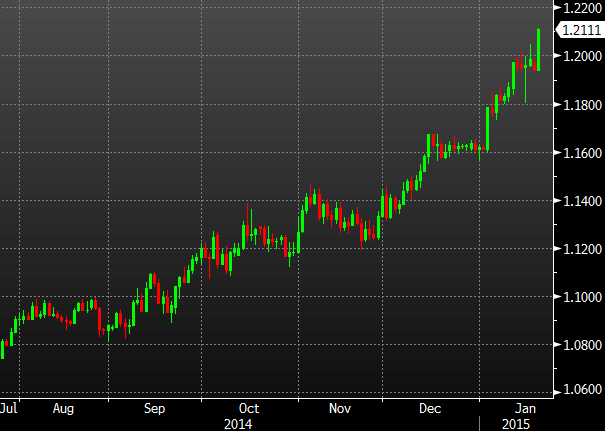Preview of the Bank of Canada decision on January 21, 2015 at 10 am ET (1500 GMT)
The Bank of Canada will be forced to chance its guidance on Wednesday. Falling oil prices, lower inflation and a slowing economy will spark a shift from neutral to dovish in a move that could weigh on the Canadian dollar.
In the most-recent statement on Dec 3, the BOC noted that falling oil prices were tempered by a better US economy, Canadian dollar depreciation and government tax breaks but since then, oil has fallen another $22 and there are signs of layoffs in the oil patch. A slower global economy also outweighs and marginal improvement in the US since then.
The key line in the statement is the final one:
Overall, the balance of risks falls within the zone for which the current stance of monetary policy is appropriate and therefore the target for the overnight rate remains at 1 per cent.
Look for that to be replaced with something that indicates the next move in rates could be lower.
What’s priced in?
To give you a sense of where the market stands, the OIS is pricing in a 20% chance of a cut by May and a 40% chance of a cut before year end. If the BOC makes it sound that a cut is more likely than not, the direction for CAD is down.
For this meeting, market has likely priced in only a slight change in wording, not a hint at anything imminent. Even with just that, the momentum in USD/CAD is likely to continue moving to the upside although a kneejerk move is less likely. Something more explicit would drive a quick and substantial (+175 pips) move.

Stephen Poloz – the hand-talking BOC leader
Key data points since the BOC decision on Dec 3:
- Nov employment -10.7K vs 0.0K exp (but full-time jobs strong)
- Dec employment -4.3K vs +15.0K exp (but full-time jobs very strong)
- Nov core CPI 2.1% y/y vs 2.4% exp
- Oct retail sales 0.0% vs -0.3% exp
- Oct GDP 0.3% vs 0.1% exp
- BOC business outlook for future sales +8 vs +29 exp
- Nov manufacturing sales -1.4% vs 0.7% exp
Bank of Canada forecasts will also be a driver
On Tuesday, the IMF lowered its forecast for Canada this year to 2.3% from 2.4% and for 2016 to 2.1% from 2.4%. Both moves came despite solid upward revisions to its US growth estimates.
The market expects that Bank of Canada to do the same. The most recent BOC forecast was in October s for 2.4% growth in 2015 and 2.2% in 2016. Those are nearly-certain to be downgraded.
Equally important will be CPI forecasts. Lowered estimates for 2015 (currently 1.8%) might be overlooked by the BOC because it’s too late to influence it but 2016 will be key and a drop from 1.9% to 1.6% or lower would imply possible rate cuts.
Code words
The Bank of Canada likes to talk about ‘full capacity’ in the economy and the ‘output gap’. Those terms are generally used to describe the time it will take before there is no unused capacity or ‘slack’ in the economy. That refers to idled factories and surplus workers. The thinking is that once there are no more workers waiting around for jobs, it will start to create inflation.
A hint about what’s to come came last week from Bank of Canada deputy Tim Lane who said cheap oil could delay Canada’s return to potential.
If the BOC used similar language without taking an outright dovish stance, it’s likely to be slightly-positive for the Canadian dollar (negative for USD/CAD), especially if officials also say they will look through a drop in CPI and are still optimistic about 2016.
How to trade it
I see substantial risks tilted toward worry about global growth and the effects of plunging oil prices on the Canadian economy and inflation. That’s highly likely to outweigh better US growth and a lower Canadian dollar.
The market tends to be sleepy when it comes to the Canadian dollar and doesn’t really move until the headlines hinting at rate cuts are plain to see. Even though USD/CAD has risen to 1.21, don’t underestimate how much further it could run.

USDCAD daily chart Jan 20 2015



